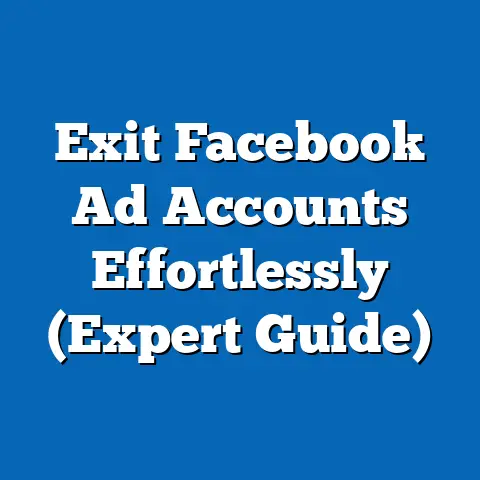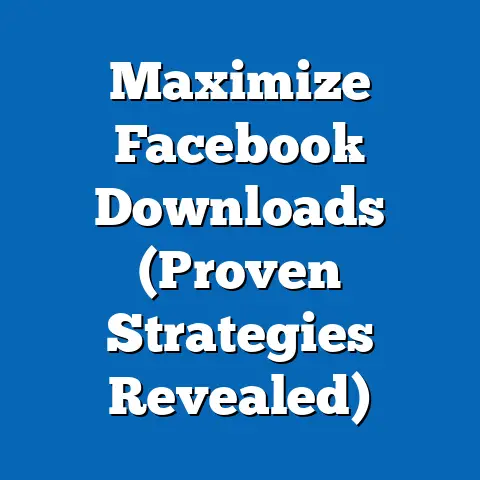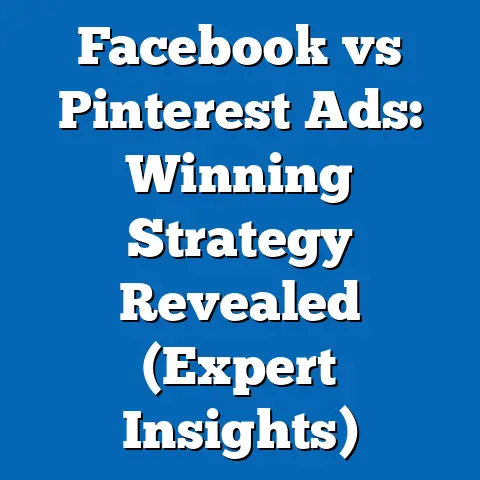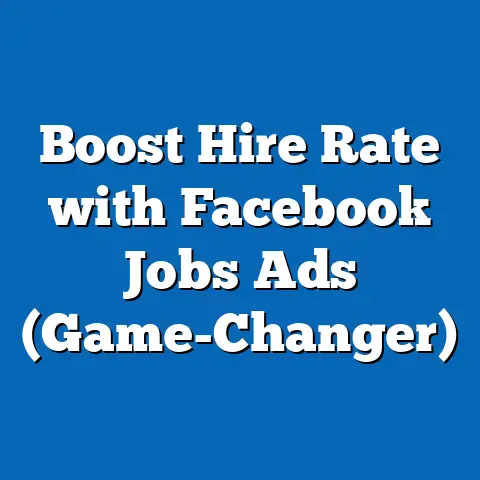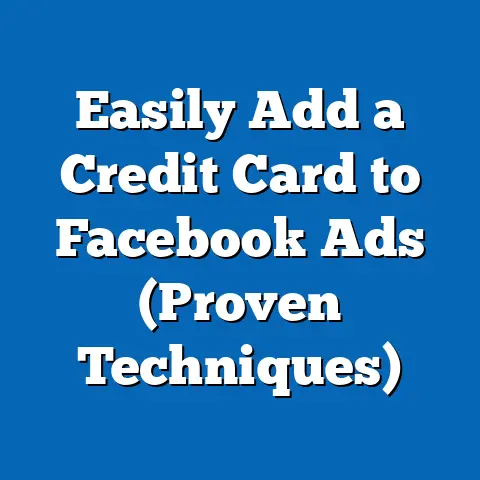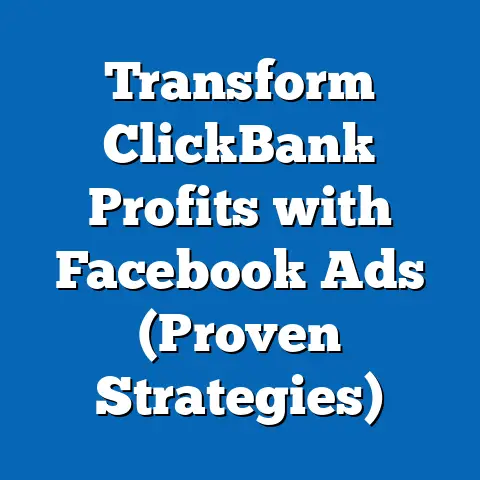Unlock Facebook’s Recent Ads (Game-Changing Insights)
What if you could tap into the secrets behind Facebook’s latest advertising strategies and transform your marketing approach overnight? It sounds like a bold claim, I know. But as a digital marketing specialist who’s been navigating the ever-shifting sands of Facebook advertising for years, I can tell you that keeping up with the platform’s constant evolution is the key to staying ahead of the curve.
Facebook advertising isn’t what it used to be. Gone are the days of simply throwing up an ad and hoping for the best. The platform has become incredibly sophisticated, with powerful algorithms, advanced targeting options, and a constantly evolving landscape of ad formats. To succeed today, you need to understand these changes and adapt your strategies accordingly.
In this guide, I’m going to walk you through the game-changing insights that will help you unlock the full potential of Facebook’s recent ad updates. We’ll delve into everything from the evolution of the platform to the latest targeting strategies and creative best practices. I’ll share my own experiences, offer data-backed insights, and provide actionable tips that you can implement immediately to improve your ad performance. So, let’s dive in and discover how you can revolutionize your Facebook advertising efforts.
The Evolution of Facebook Ads
To truly understand where Facebook advertising is today, we need to take a quick trip down memory lane. Back in the early days, Facebook ads were relatively simple. They were primarily focused on driving likes and website traffic, and the targeting options were fairly limited. I remember when I first started using Facebook Ads, it felt like throwing darts in the dark. You could target by basic demographics like age and location, but it was difficult to really hone in on your ideal customer.
Over the years, Facebook has undergone a massive transformation. The introduction of Business Manager, Power Editor (now Ads Manager), and custom audiences revolutionized the way advertisers could target and manage their campaigns. The platform also introduced a wider variety of ad formats, from carousel ads to video ads, allowing advertisers to tell more compelling stories and engage with their audience in new ways.
One of the most significant changes has been the evolution of Facebook’s algorithm. In the early days, the algorithm was relatively simple, prioritizing content from friends and family. However, as the platform grew, the algorithm became more sophisticated, taking into account a wide range of factors, including user engagement, ad relevance, and landing page experience. This meant that advertisers had to focus on creating high-quality, relevant ads that resonated with their target audience.
These changes have had a profound impact on the effectiveness of Facebook advertising. While it’s become more challenging to reach your target audience, it’s also become more rewarding. By understanding the platform’s evolution and adapting your strategies accordingly, you can achieve incredible results.
Key Takeaway: Understanding the history of Facebook advertising is crucial for appreciating the platform’s current capabilities and future direction.
Recent Updates and Features
Facebook is constantly rolling out new updates and features to its Ads Manager, and it can be difficult to keep up with all the changes. However, staying informed about these updates is essential for maximizing your ad performance. Let’s take a look at some of the most recent and impactful updates.
- Advantage+ Campaign Budget: This feature allows Facebook’s algorithm to automatically distribute your budget across your ad sets, based on which ones are performing best. I’ve found this to be particularly useful for campaigns with multiple ad sets targeting different audiences. It takes the guesswork out of budget allocation and helps you get the most out of your ad spend.
- Advantage+ App Campaigns: Designed specifically for app advertisers, this feature simplifies the campaign creation process and uses machine learning to optimize your ads for app installs and in-app actions. If you’re promoting an app, this is a must-try.
- AI-Powered Creative Optimization: Facebook is increasingly using AI to help advertisers create more effective ads. This includes features like automatic ad variations, creative fatigue detection, and personalized ad recommendations. I’ve been experimenting with these features and have seen some promising results.
- Enhanced Measurement Tools: Facebook has improved its measurement tools to provide advertisers with more accurate and granular data. This includes features like conversion API and aggregated event measurement, which help you track conversions more reliably, even with privacy restrictions.
Example: A local e-commerce business selling handmade jewelry used Advantage+ Campaign Budget and AI-powered creative optimization. They saw a 30% increase in conversions and a 20% decrease in cost per acquisition (CPA) compared to their previous campaigns.
Key Takeaway: Staying up-to-date with Facebook’s latest updates and features is crucial for maximizing your ad performance. Experiment with new features and see how they can benefit your campaigns.
Game-Changing Insights from Facebook’s Algorithm
Facebook’s algorithm is the engine that drives the platform, and understanding how it works is essential for successful advertising. The algorithm is constantly evolving, taking into account a wide range of factors to determine which content to show to each user.
Here are some key insights into how the algorithm works and what you can do to align with it:
- Prioritize User Experience: Facebook’s primary goal is to provide a positive user experience. This means that the algorithm prioritizes content that is engaging, relevant, and high-quality. Avoid using clickbait tactics or deceptive advertising practices, as this can negatively impact your ad performance.
- Focus on Relevance: The algorithm favors ads that are relevant to the user’s interests and demographics. This is why it’s so important to target your ads effectively and create ad copy that resonates with your target audience.
- Encourage Engagement: The more engagement your ads receive (likes, comments, shares), the more likely they are to be shown to a wider audience. Encourage engagement by asking questions, running contests, or creating interactive ad formats.
- Optimize for Mobile: The majority of Facebook users access the platform on their mobile devices, so it’s essential to optimize your ads for mobile. This means using mobile-friendly ad formats, creating short and concise ad copy, and ensuring that your landing pages are mobile-responsive.
Data-Backed Insight: Studies have shown that ads with high relevance scores (a metric that measures how relevant your ad is to your target audience) tend to have lower costs and higher conversion rates.
Key Takeaway: Understanding and aligning with Facebook’s algorithm is crucial for maximizing your ad performance. Focus on creating high-quality, relevant ads that provide a positive user experience.
Audience Targeting Strategies
One of the most powerful aspects of Facebook advertising is its advanced audience targeting options. Facebook allows you to target your ads based on a wide range of factors, including demographics, interests, behaviors, and connections.
Here are some key targeting strategies that you can use to reach the right audience for your campaigns:
- Custom Audiences: Custom Audiences allow you to target your ads to people who have already interacted with your business, such as website visitors, email subscribers, or app users. This is a highly effective way to re-engage your existing customers and drive conversions. I’ve used custom audiences extensively to target users who abandoned their shopping carts, and the results have been fantastic.
- Lookalike Audiences: Lookalike Audiences allow you to target your ads to people who are similar to your existing customers. This is a great way to expand your reach and find new customers who are likely to be interested in your products or services. Facebook uses its algorithm to identify the common characteristics of your existing customers and then finds other users who share those characteristics.
- Detailed Targeting: Detailed Targeting allows you to target your ads based on a wide range of interests, behaviors, and demographics. This is a powerful way to hone in on your ideal customer and create highly targeted ad campaigns. For example, you can target people who are interested in specific hobbies, who have recently made a purchase in a certain category, or who have a specific job title.
Example: A fitness studio used Custom Audiences to target people who had visited their website but hadn’t signed up for a membership. They offered these users a special discount and saw a 20% increase in membership sign-ups.
Key Takeaway: Facebook’s advanced audience targeting options are a powerful tool for reaching the right audience for your campaigns. Experiment with different targeting strategies and see what works best for your business.
Creative Ad Formats and Best Practices
In today’s crowded digital landscape, it’s more important than ever to create ads that stand out and capture your audience’s attention. Facebook offers a wide range of ad formats, each with its own unique strengths and weaknesses.
Here are some of the most popular ad formats and best practices for creating effective ads:
- Image Ads: Image Ads are the simplest and most common ad format. They consist of a single image, ad copy, and a call-to-action button. To create effective image ads, use high-quality images that are visually appealing and relevant to your target audience. Keep your ad copy short and concise, and use a clear and compelling call-to-action.
- Video Ads: Video Ads are a powerful way to tell your brand’s story and engage with your audience. They can be used to showcase your products or services, share customer testimonials, or simply entertain your audience. Keep your videos short and engaging, and use captions to make them accessible to viewers who are watching without sound.
- Carousel Ads: Carousel Ads allow you to showcase multiple images or videos in a single ad. This is a great way to highlight different products or features, or to tell a more complex story. Use high-quality visuals and compelling ad copy to encourage users to swipe through the carousel.
- Collection Ads: Collection Ads are a mobile-first ad format that allows you to showcase your products in a visually appealing way. They consist of a cover image or video, followed by a selection of related products. Collection Ads are a great way to drive traffic to your e-commerce store and increase sales.
- Reels Ads: With the rise of short-form video, Reels Ads have become increasingly popular. These ads appear between organic Reels content and offer a fun, engaging way to reach your audience. Keep your Reels Ads authentic and entertaining, and use trending sounds and effects to capture attention.
Insight: Video ads generally outperform static image ads in terms of engagement and conversion rates. However, it’s important to create high-quality videos that are relevant to your target audience.
Key Takeaway: Experiment with different ad formats and find the ones that work best for your business. Focus on creating high-quality, visually appealing ads that resonate with your target audience.
Measuring Success and ROI
Measuring the success of your Facebook ad campaigns is essential for optimizing your ad spend and achieving your business goals. Facebook provides a wide range of metrics that you can use to track your ad performance.
Here are some of the key metrics that you should focus on:
- Reach: Reach measures the number of unique people who saw your ad. This is a good indicator of how widely your ad is being distributed.
- Impressions: Impressions measure the number of times your ad was displayed. This can be higher than reach if people see your ad multiple times.
- Click-Through Rate (CTR): CTR measures the percentage of people who clicked on your ad after seeing it. This is a good indicator of how engaging your ad is.
- Cost Per Click (CPC): CPC measures the average cost you pay each time someone clicks on your ad. This is a good indicator of how efficient your ad spend is.
- Conversion Rate: Conversion Rate measures the percentage of people who completed a desired action (e.g., making a purchase, signing up for a newsletter) after clicking on your ad. This is a key indicator of your ad’s effectiveness.
- Return on Ad Spend (ROAS): ROAS measures the revenue you generate for every dollar you spend on advertising. This is the ultimate measure of your ad campaign’s success.
Example: A clothing retailer tracked their ROAS for different ad campaigns and found that video ads targeting lookalike audiences had the highest ROAS. They then increased their budget for these campaigns and saw a significant increase in overall revenue.
Key Takeaway: Track your ad performance closely and use the data to optimize your ad spend and improve your ROI. Focus on the metrics that are most relevant to your business goals.
Future Trends in Facebook Advertising
The world of Facebook advertising is constantly evolving, and it’s important to stay ahead of the curve to remain competitive. Here are some of the future trends that I believe will shape the platform in the years to come:
- Increased Use of AI and Machine Learning: Facebook is increasingly using AI and machine learning to automate various aspects of advertising, from ad creation to targeting to optimization. This trend is likely to continue, making it easier for advertisers to create effective campaigns and reach their target audience.
- Emphasis on Privacy: As privacy concerns continue to grow, Facebook is likely to introduce more privacy-focused features and policies. This may make it more challenging to target your ads effectively, but it will also create opportunities for advertisers to build trust with their audience by being transparent and respectful of their privacy.
- Growth of Augmented Reality (AR) and Virtual Reality (VR): AR and VR technologies are becoming increasingly popular, and Facebook is investing heavily in these areas. In the future, we may see more AR and VR ad formats that allow users to interact with your brand in new and immersive ways.
- Integration of E-commerce: Facebook is increasingly integrating e-commerce features into its platform, making it easier for users to purchase products directly from their news feed. This trend is likely to continue, creating new opportunities for advertisers to drive sales and revenue.
Key Takeaway: Stay informed about the latest trends and developments in Facebook advertising and be prepared to adapt your strategies accordingly. The future of advertising is likely to be more automated, personalized, and privacy-focused.
Conclusion
So, what if you could tap into the secrets behind Facebook’s latest advertising strategies and transform your marketing approach overnight? As we’ve explored in this guide, the answer is a resounding yes! By understanding the evolution of Facebook ads, staying up-to-date with the latest features, aligning with the algorithm, leveraging advanced targeting options, creating compelling ads, and measuring your results, you can unlock the full potential of the platform and achieve your business goals.
The key to success is to stay informed, be adaptable, and never stop experimenting. The world of Facebook advertising is constantly changing, but by embracing these changes and focusing on providing value to your audience, you can stay ahead of the curve and achieve incredible results.
Now, I’d love to hear from you. What are your biggest challenges with Facebook advertising? What strategies have you found to be most effective? Share your thoughts and experiences in the comments below! Let’s learn from each other and build a community of successful Facebook advertisers.

